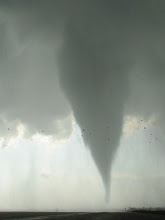I had the day off on the 26th and left at 430P.M. with a rough target of Chanute KS. Initiation probably wouldn't occur until after 9 P.M. as a strong 700mb thermal ridge was cresting over the western edge of the moist axis during the afternoon and early evening. Still, very strong cold advection in the 800-500mb layer was forecast to overspread ridiculous boundary layer moisture--ML dewpoints around 15°C in eastern KS and western MO--resulting in strong low-level destabilization overnight regardless of diurnal cooling.
In the end, I was caught generally on the southwest edge of where storms initiated--which at first seemed to be on the northern fringe of the richest boundary layer moisture oriented SW-NE, though storms gradually formed farther south as well. Still, I was able to catch up with a well-developed cell moving from Iola to Paola between 10 and 11 P.M., right about the time it received a severe thunderstorm warning. Shockingly, the overcast stratus that had accompanied the moisture surge had broken up several hours prior (before sunset)... and even with the ramping up LLJ, redevelopment of stratus had remained very patchy. Thus I had a great look of the storm, particularly as the lights from south metro KC illuminated it a bit (lightning activity was semi-limited). The structure was quite nice, compact and decidedly low-precipitation, with a flanking line trailing to the southwest. At cloud base it looked a little messier and possibly OFD, though a lowering/wall cloud was present on the leading edge of the rain free base. Wasn't able to document the storm very well even with video given the storm speed... not long after it raced away from me thru the metro, moving at about 60mph.
Below is a modified NAM sounding and composite profiler hodograph to represent the storm. Note the unseasonably moist boundary layer and strong low-level bouyancy, which was verified by the 06Z Lamont OK sounding, However, with northward extent, 500-1000m flow veered a good bit during the evening... and given the storm was not rightward-deviant, low-level shear wasn't as strong as I'd have liked to seen for a tornado threat given the strong environmental wind fields and total CAPE AOB 1000 J/kg. So I think shear was just a bit too straight-line/unidirectional to allow the storms to do much, though I also wonder if a more well-defined source for significant vertical motion wouldn't have helped the storms fare better. Convection seemed to become more organized and increasingly supercellular later on toward northeast MO and west central IL (STL even cranked out some tornado warnings), where hodographs remained far more curved all night long and storms tried to turn to the right of the mean wind... though low-level static stability was probably increasing near the effective warm front, which was also farther removed from the richest BL moisture. Hodographs similarly remained more curved all night farther south into far southeast KS and northcentral/northeast OK... I'm not sure how to account for the lack of activity there, though I haven't reviewed that part of the event super closely as of yet.
As strong synoptic scale lift and strengthening jet dynamics began to interact with very strong low-level frontogenetical forcing that accompanied the synoptic cold front, a few bow echoes developed and raced through the KS-MO border region between 08-12Z, causing isolated damage and up to 80mph wind gusts. If the more favorable synoptic lift had not been lagging the warm sector, I think a tornado outbreak would have likely occurred over eastern KS, eastern OK, and MO that night.



